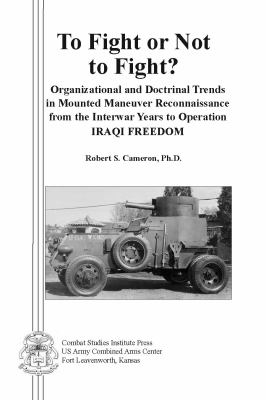
Book
|
To fight or not to fight? : organizational and doctrinal trends in mounted maneuver reconnaissance from the interwar years to Operation Iraqi Freedom
-- Organizational and doctrinal trends in mounted maneuver reconnaissance from the interwar years to Operation Iraqi Freedom
Copies
18 Total copies, 17 Copies are in,
1 Copies are out.
Title
To fight or not to fight? : organizational and doctrinal trends in mounted maneuver reconnaissance from the interwar years to Operation Iraqi Freedom -- Organizational and doctrinal trends in mounted maneuver reconnaissance from the interwar years to Operation Iraqi Freedom
Call No
UA30
Subjects
United States. Army. Cavalry--History--20th century.
United States. Army. Cavalry--History--21st century.
United States. Army--Armored troops--History--20th century.
United States. Army--Armored troops--History--21st century.
United States. Army
United States. Army. Cavalry.
United States. Army. Cavalry--History.--21st century. (DLC)n 82006359
United States. Army--Armored troops--HISTORY.--21st century. (DLC)n 79063202
Organizational change--United States--History.
Military doctrine--United States--History.
Maneuver warfare--History.
Military reconnaissance--History.
Armed Forces--Armored troops.
Maneuver warfare.
Military doctrine.
Military reconnaissance.
Organizational change.
History.
Military history.
Organizational change--UNITED STATES--History.
Military doctrine--United States--History.
Maneuver warfare--History.
Military reconnaissance--History.
United States--History, Military--20th century.
United States--History, Military--21st century.
United States.
(DLC)n 78095330 United States--History, Military--21st century.
United States. Army. Cavalry--History--21st century.
United States. Army--Armored troops--History--20th century.
United States. Army--Armored troops--History--21st century.
United States. Army
United States. Army. Cavalry.
United States. Army. Cavalry--History.--21st century. (DLC)n 82006359
United States. Army--Armored troops--HISTORY.--21st century. (DLC)n 79063202
Organizational change--United States--History.
Military doctrine--United States--History.
Maneuver warfare--History.
Military reconnaissance--History.
Armed Forces--Armored troops.
Maneuver warfare.
Military doctrine.
Military reconnaissance.
Organizational change.
History.
Military history.
Organizational change--UNITED STATES--History.
Military doctrine--United States--History.
Maneuver warfare--History.
Military reconnaissance--History.
United States--History, Military--20th century.
United States--History, Military--21st century.
United States.
(DLC)n 78095330 United States--History, Military--21st century.
Language
English
Published
Fort Leavenworth, Kan. : Combat Studies Institute Press, US Army Combined Arms Center, 2010.
Publication Desc
xx, 631 p. : ill. ; 24 cm.
ISBN
9780982328392
(pbk.)
LCCN
2009051654









